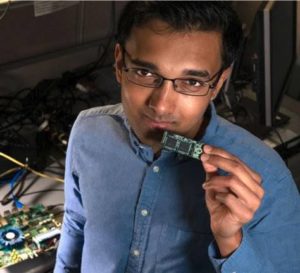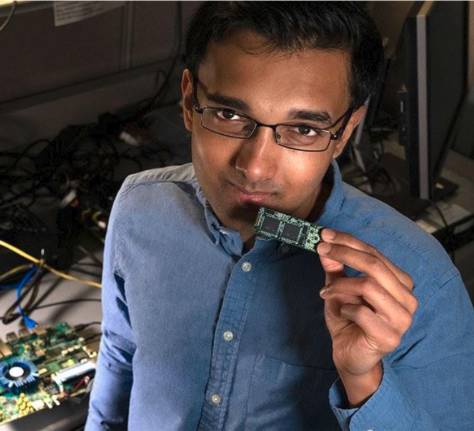
Intel Labs’ Nabil Imam holds a Loihi neuromorphic test chip in his Santa Clara, California, neuromorphic computing lab. He and a research team from Cornell University are building mathematical algorithms on computer chips that mimic what happens in your brain’s neural network when you smell something. (Credit: Walden Kirsch/Intel Corporation)
Researchers have demonstrated how neuromorphic chips can mimic olfactory senses for use in industrial and medical applications.
In a joint paper published in Nature Machine Intelligence, researchers from Intel Labs and Cornell University demonstrated the ability of Intel’s neuromorphic research chip, Loihi, to learn and recognize hazardous chemicals in the presence of significant noise and occlusion. Loihi learned each odor with just a single sample without disrupting its memory of the previously learned scents. It demonstrated superior recognition accuracy compared to conventional state-of-the-art methods, including a deep learning solution that required 3000x more training samples per class to reach the same level of classification accuracy.
We are developing neural algorithms on Loihi that mimic what happens in your brain when you smell something,” said Nabil Imam, senior research scientist in Intel’s Neuromorphic Computing Lab. “This work is a prime example of contemporary research at the crossroads of neuroscience and artificial intelligence and demonstrates Loihi’s potential to provide important sensing capabilities that could benefit various industries.”
The hazardous odors learned and recognized by Loihi pose a danger to public health, serving as precursors in the manufacture of explosives, narcotics, and polymers. The findings demonstrate the promise of neuromorphic chips to recognize these odors under real-world conditions more effectively than conventional solutions and give us a view into potential use cases of neuromorphic technology. In the future, portable “electronic nose systems” with neuromorphic chips could be used by doctors to diagnose diseases, by airport security to detect weapons and explosives, by police and border control to more easily find and seize narcotics, and even to create more effective at- home smoke and carbon monoxide detectors.
In this video, Mike Davies, director of Intel’s Neuromorphic Computing Lab, describes the aim behind neuromorphic processor research: to make a chip that mimicks the human brain.
Using a neural algorithm derived from the architecture and dynamics of the brain’s olfactory circuits, researchers from Intel and Cornell University trained Intel’s Loihi neuromorphic research chip to learn and recognize the scents of 10 hazardous chemicals. To do so, the team used a dataset consisting of the activity of 72 chemical sensors in response to these smells and configured the circuit diagram of biological olfaction on Loihi. The chip quickly learned the neural representation of each of the smells and recognized each odor even when significantly occluded, demonstrating a promising future for the intersection of neuroscience and artificial intelligence.




